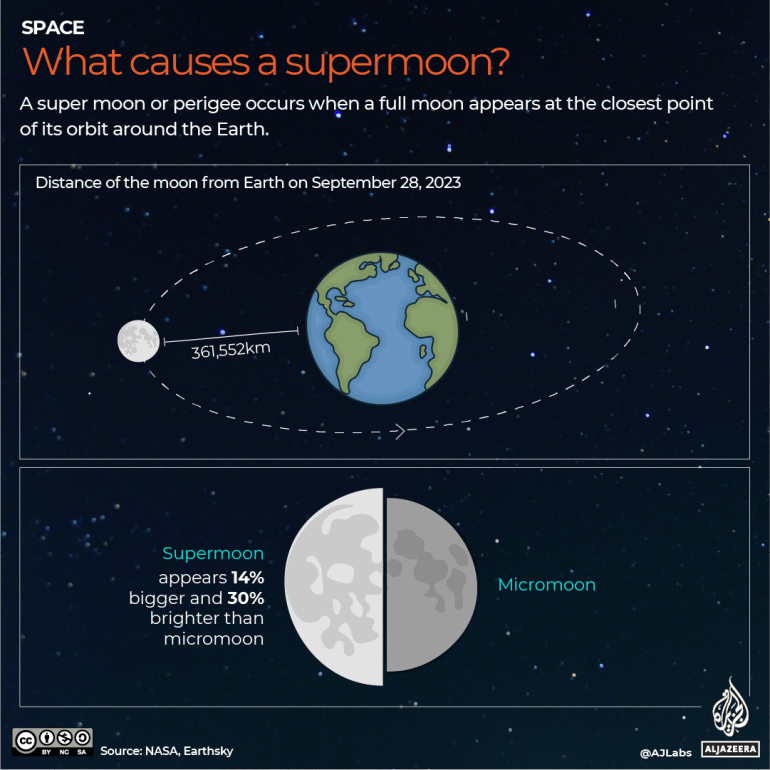ARTICLE AD BOX
On the night of September 17, the Earth, sun and moon will align to create three celestial events.
In many places, depending on the time zones, people will have the opportunity to witness a harvest moon, a supermoon, and a lunar eclipse as the full moon rises.
Here’s what you need to know about these events:
First things first: What is a full moon?
According to NASA, a full moon is defined as the moment when the moon is exactly 180 degrees opposite to the sun. During this time, the sun is almost fully illuminating the Earth’s satellite.
NASA says this month’s full moon will reach its peak on Tuesday, September 17 at 10:35pm EDT (or at 02:35 GMT on Wednesday, September 18).
Full moons generally rise around sunset and set around sunrise. There are eight phases of the moon cycle, which repeats every 29.5 days.

What is a partial lunar eclipse?
A partial lunar eclipse is the time when a fraction of the full moon is covered by the Earth’s shadow.
The shadow expands and then recedes, but never reaches the totality phase. In contrast, during a total lunar eclipse, the Earth’s full shadow completely covers the moon.
The moon will start moving into the Earth’s partial shadow at 8:41pm EDT on Tuesday (00:41 GMT on Wednesday). The initial dimming might be subtle until the upper edge of the moon begins to enter the full shadow at 10:13pm EDT on Tuesday (02:13 GMT on Wednesday).
The eclipse will peak at 10:44pm EDT on Tuesday (02:44 GMT Wednesday), with just the top eight percent of the moon in full shadow.
The moon will exit the full shadow by 11:16pm EDT (03:16 GMT) and will complete its departure from the partial shadow by 12:47am EDT, or 04:47 GMT on Wednesday morning.
 Partial lunar eclipse observed in India [File: Satish Bate/Getty Images]
Partial lunar eclipse observed in India [File: Satish Bate/Getty Images]What is a supermoon?
This moon will also be a supermoon.
A supermoon is defined as an astronomical phenomenon where a full moon looks larger and brighter than usual. It happens when the full moon occurs at the same time that its orbit is closest to the Earth.
According to NASA, the term “supermoon” was coined by astrologer Richard Nolle in 1979 to describe a full moon that occurs when the moon is “within 90 percent of its closest to Earth.”
In essence, the Earth, moon and sun are all in a line at this point. At the opposite end of the moon sighting spectrum is the micromoon — when the full moon looks especially small and dull because it coincides with the point in the moon’s orbit when it is farthest from the Earth.
 (Al Jazeera)
(Al Jazeera)Is this also a harvest moon?
The harvest moon is the closest full moon to the Northern Hemisphere’s autumn equinox, which this year will take place on September 22 at 12:43 GMT.
So yes, this is also a harvest moon.
According to the Farmer’s Almanac, “this full moon rises at nearly the same time – around sunset – for several evenings in a row”. This results in an abundance of bright moonlight early in the evening.
 A nearly full harvest moon rises over Penobscot Bay, in Maine, the US [File: Robert F. Bukaty/AP]
A nearly full harvest moon rises over Penobscot Bay, in Maine, the US [File: Robert F. Bukaty/AP]This phenomenon has traditionally aided farmers in harvesting their summer-grown crops by giving them several extra evenings of moonlight. Hence, it is called the harvest moon.
The harvest moon has a shade of orange and red. It appears bigger and brighter than other full moons because of an optical illusion that occurs when a moon is close to the horizon.
It gets its colour because the moonlight is filtered through more of the Earth’s atmospheric particles than when it is overhead.
 [Al Jazeera]
[Al Jazeera]So all together, how will Tuesday’s event unfold?
- The full moon will reach its peak on Tuesday at 10:35pm EDT (Wednesday at 02:35 GMT). At this time, it will also reach its peak of illumination.
- The peak of the eclipse will be at 10:44pm EDT (02:44 GMT).
The total duration of the partial lunar eclipse is four hours and six minutes.
For observers in the Eastern Time Zone of the United States, the eclipse will reach its darkest phase around 10:44pm EDT on September 17.
In Europe and Africa, the eclipse will be visible during the early morning hours of September 18. In the United Kingdom, the eclipse will be most prominent around 3:44am BST time on September 18.
People living in the Gulf will not be able to catch the peak of the eclipse, but they will be able to see the moment when the partial eclipse starts at 05:15am local time, on Wednesday.
In the map below, you can see which countries will be able to see the peak of the eclipse on Tuesday.
 [Al Jazeera]
[Al Jazeera]How to watch the lunar eclipse and the harvest moon?
If you are in the right time zone, a casual stargazer can watch the lunar eclipse, although it’s preferable to be in darker locations.
NASA also recommends using a pair of binoculars “with a magnification of 7 at a minimum”, noting that “a magnification of 10 or 15 will provide more detail; you may need a tripod to steady them.”

 3 months ago
58
3 months ago
58








 English (US)
English (US)